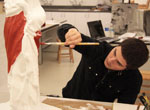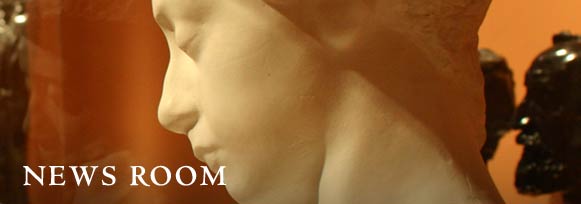Exhibition Reveals Original Color on Ancient Marble Sculpture and Dispels Misconceptions
True Colors: Rediscovering Pigments on Greco-Roman Marble Sculpture
March 16 – August 7, 2011
Stanford, California — The Cantor Arts Center at Stanford University announces “True Colors: Rediscovering Pigments on Greco-Roman Marble Sculpture,” an exhibition that challenges our modern vision of ancient white-marble figures with scientific evidence that Greco-Roman marble statuary was originally brightly colored. The exhibition opens Wednesday, March 16 and continues through August 7. Admission is free.
For this display, a Cantor Arts Center team went into the laboratory to uncover traces of the bright pigments that originally covered a Hellenistic sculpture, from ancient Samaria, that is now in the Center's collection. Using x-ray fluorescence (XRF), a team led by Stanford chemical engineering student Ivy Nguyen (class of 2013) found the traces of pigment — not visible to the naked eye — that remain on the pale marble sculpture. Said Nguyen, “Science can give us a deeper understanding of art.”
Nguyen's efforts build on others' work that has led to the realization that ancient marble sculpture was never meant to be white. As Nguyen puts it: “The ancient Greeks would have been mortified to see these sculptures bare as we do today.” Rather than relying solely on visible traces of ancient pigments to determine the original colors on the marble sculpture, the Center's team used a handheld XRF device to find the “ghost images” of a remaining base layer of paint. “While a few other museums have presented displays similar to ‘True Colors,’ we have not yet seen an exhibition or publication presenting use of this advanced technology in relation to Hellenistic sculpture,” said Susan Roberts-Manganelli, who is manager of collections, exhibitions, and conservation at the Center. She is also a leading member of the team that examined the works and planned the exhibition.
Once the trace pigments were identified (elements such as lead and gold, which are not native to marble), the exhibition team used 3D rapid prototyping technology to cast two replicas of the sculpture. These colorful replicas appear alongside the original marble figure. One replica displays colors from the source pigments found on the marble, while the other is painted with an educated guess as to the many vibrant layers of paint that once would have graced such a sculpture.
The exhibition is designed to walk viewers through the laboratory process with cases displaying pigments used in ancient times, wall-mounted images of the analysis, and small, painted terra cotta works from the Center's ancient collection. “True Colors” is made possible by a grant from the Stanford Institute for Creativity and the Arts, the Lynn Krywick Gibbons Exhibitions Fund, and a gift from Andrea and Lubert Stryer.
# # #
VISITOR INFORMATION: Cantor Arts Center is open Wednesday – Sunday, 11 am - 5 pm, Thursday until 8 pm. Admission is free. The Center is located on the Stanford campus, off Palm Drive at Museum Way. Parking is free after 4 pm weekdays and all day on weekends. Information: 650-723-4177, museum.stanford.edu.
PUBLICITY PHOTOS: For high-resolution images, contact PR Assistant Manager, Margaret Whitehorn: 650-724-3600, mmwhite@stanford.edu

Sculpture in the conservation lab.

Stanford student Ivy Nguyen uses x-ray fluorescence (XRF) to test the marble sculpture for pigments that may reveal the original color that it was painted.


Stanford students work on painting the replica sculpture.

The original marble sculpture. Sebaste (now Samaria), Palestinian Territories
Maenad, c. 4 BCE – 25 CE
Marble.
By exchange with Harvard University Art Museums,
for gifts from Stanford Family Collections, 1998.2



